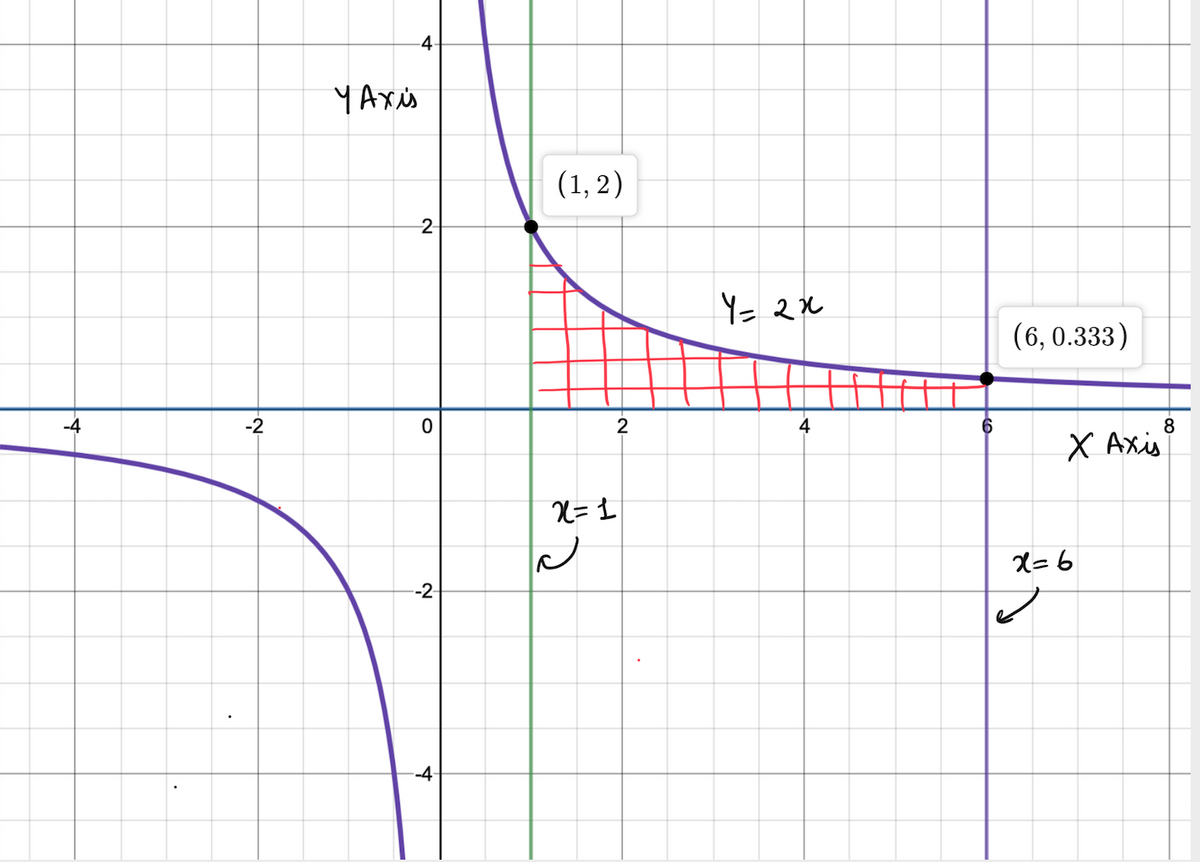Calculus: Early Transcendentals
8th Edition
ISBN:9781285741550
Author:James Stewart
Publisher:James Stewart
Chapter1: Functions And Models
Section: Chapter Questions
Problem 1RCC: (a) What is a function? What are its domain and range? (b) What is the graph of a function? (c) How...
Related questions
Question
Please use Fundamental theorem of calculus for #8 and answer both questions thank you so much!
![**Problem 8:** Find the area of the region bounded by the graphs of the equation \( f(x) = \frac{2}{x} \), \( y = 0 \), \( x = 1 \), and \( x = 6 \).
This problem requires determining the area under the curve defined by the function \( f(x) = \frac{2}{x} \) from \( x = 1 \) to \( x = 6 \), and above the x-axis (\( y = 0 \)). This problem involves integrating the function \( f(x) \) over the interval \([1, 6]\).](/v2/_next/image?url=https%3A%2F%2Fcontent.bartleby.com%2Fqna-images%2Fquestion%2F7a908816-dcaf-4aa4-8dd6-7dd2f0aea84f%2F22b6aef5-cd78-4a0f-bf4f-fc8132a82aef%2F3f39w3c.png&w=3840&q=75)
Transcribed Image Text:**Problem 8:** Find the area of the region bounded by the graphs of the equation \( f(x) = \frac{2}{x} \), \( y = 0 \), \( x = 1 \), and \( x = 6 \).
This problem requires determining the area under the curve defined by the function \( f(x) = \frac{2}{x} \) from \( x = 1 \) to \( x = 6 \), and above the x-axis (\( y = 0 \)). This problem involves integrating the function \( f(x) \) over the interval \([1, 6]\).
![## Mean Value Theorem for Integrals: Example Problem
### Problem Statement:
9) Find the value(s) of \( c \) guaranteed by the Mean Value Theorem for Integrals for the function over the given interval.
\[ f(x) = 2 \sin x \]
\[ \left[ 0, \frac{\pi}{3} \right] \]
### Solution Process:
To apply the Mean Value Theorem for Integrals, which states that if \( f \) is continuous on \([a, b]\), then there exists a number \( c \) in \((a, b)\) such that:
\[ \int_a^b f(x) \, dx = f(c) (b - a) \]
First, find the definite integral of \( f(x) \) over the interval \([0, \frac{\pi}{3}]\).
\[ \int_0^{\frac{\pi}{3}} 2 \sin x \, dx \]
Next, find the antiderivative of \( 2 \sin x \):
\[ 2 \int_0^{\frac{\pi}{3}} \sin x \, dx \]
\[
= 2 \left[ -\cos x \right]_0^{\frac{\pi}{3}}
\]
Plug in the bounds of the interval:
\[
= 2 \left[ -\cos \left( \frac{\pi}{3} \right) + \cos (0) \right]
\]
Evaluate the trigonometric functions:
\[
= 2 \left[ -\frac{1}{2} + 1 \right]
\]
\[
= 2 \left[ \frac{1}{2} \right]
\]
\[
= 1
\]
So, the integral evaluates to 1.
By the Mean Value Theorem for Integrals:
\[
\int_0^{\frac{\pi}{3}} 2 \sin x \, dx = f(c) \left( \frac{\pi}{3} - 0 \right)
\]
We know the integral is 1, so set up the equation:
\[
1 = 2 \sin(c) \left( \frac{\pi}{3} \right)
\]
Solve for \( \sin(c) \):
\[
1 = \frac{2\pi}{3} \sin(c)](/v2/_next/image?url=https%3A%2F%2Fcontent.bartleby.com%2Fqna-images%2Fquestion%2F7a908816-dcaf-4aa4-8dd6-7dd2f0aea84f%2F22b6aef5-cd78-4a0f-bf4f-fc8132a82aef%2Fajdxe8k.png&w=3840&q=75)
Transcribed Image Text:## Mean Value Theorem for Integrals: Example Problem
### Problem Statement:
9) Find the value(s) of \( c \) guaranteed by the Mean Value Theorem for Integrals for the function over the given interval.
\[ f(x) = 2 \sin x \]
\[ \left[ 0, \frac{\pi}{3} \right] \]
### Solution Process:
To apply the Mean Value Theorem for Integrals, which states that if \( f \) is continuous on \([a, b]\), then there exists a number \( c \) in \((a, b)\) such that:
\[ \int_a^b f(x) \, dx = f(c) (b - a) \]
First, find the definite integral of \( f(x) \) over the interval \([0, \frac{\pi}{3}]\).
\[ \int_0^{\frac{\pi}{3}} 2 \sin x \, dx \]
Next, find the antiderivative of \( 2 \sin x \):
\[ 2 \int_0^{\frac{\pi}{3}} \sin x \, dx \]
\[
= 2 \left[ -\cos x \right]_0^{\frac{\pi}{3}}
\]
Plug in the bounds of the interval:
\[
= 2 \left[ -\cos \left( \frac{\pi}{3} \right) + \cos (0) \right]
\]
Evaluate the trigonometric functions:
\[
= 2 \left[ -\frac{1}{2} + 1 \right]
\]
\[
= 2 \left[ \frac{1}{2} \right]
\]
\[
= 1
\]
So, the integral evaluates to 1.
By the Mean Value Theorem for Integrals:
\[
\int_0^{\frac{\pi}{3}} 2 \sin x \, dx = f(c) \left( \frac{\pi}{3} - 0 \right)
\]
We know the integral is 1, so set up the equation:
\[
1 = 2 \sin(c) \left( \frac{\pi}{3} \right)
\]
Solve for \( \sin(c) \):
\[
1 = \frac{2\pi}{3} \sin(c)
Expert Solution
Question - 8

Shaded area is our required area .
Step by step
Solved in 2 steps with 2 images

Knowledge Booster
Learn more about
Need a deep-dive on the concept behind this application? Look no further. Learn more about this topic, calculus and related others by exploring similar questions and additional content below.Recommended textbooks for you

Calculus: Early Transcendentals
Calculus
ISBN:
9781285741550
Author:
James Stewart
Publisher:
Cengage Learning

Thomas' Calculus (14th Edition)
Calculus
ISBN:
9780134438986
Author:
Joel R. Hass, Christopher E. Heil, Maurice D. Weir
Publisher:
PEARSON

Calculus: Early Transcendentals (3rd Edition)
Calculus
ISBN:
9780134763644
Author:
William L. Briggs, Lyle Cochran, Bernard Gillett, Eric Schulz
Publisher:
PEARSON

Calculus: Early Transcendentals
Calculus
ISBN:
9781285741550
Author:
James Stewart
Publisher:
Cengage Learning

Thomas' Calculus (14th Edition)
Calculus
ISBN:
9780134438986
Author:
Joel R. Hass, Christopher E. Heil, Maurice D. Weir
Publisher:
PEARSON

Calculus: Early Transcendentals (3rd Edition)
Calculus
ISBN:
9780134763644
Author:
William L. Briggs, Lyle Cochran, Bernard Gillett, Eric Schulz
Publisher:
PEARSON

Calculus: Early Transcendentals
Calculus
ISBN:
9781319050740
Author:
Jon Rogawski, Colin Adams, Robert Franzosa
Publisher:
W. H. Freeman


Calculus: Early Transcendental Functions
Calculus
ISBN:
9781337552516
Author:
Ron Larson, Bruce H. Edwards
Publisher:
Cengage Learning